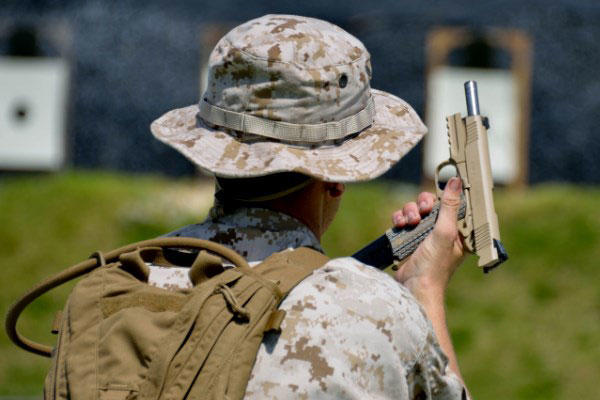The Marine Corps has authorized MARSOC operators to carry Glock pistols, since many of the elite outfit's members prefer the popular 9mm over the custom .45 pistols the service bought them in 2012.
The Corps issued a Feb. 2 Marine Administrative Message, or MARADMIN, that green-lighted Marine Corps Forces Special Operations Command, or MARSOC, units to use the Glock 19, a proven design used by many units in U.S. Special Operations Command.
The reliable, easy-to-maintain 9mm features a polymer frame and a 15-round magazine.
The Marine Corps just completed an exhaustive search for a new MARSOC pistol in 2012. The service awarded a $22.5 million contract to Colt Defense LLC., for up to 10,000 Close Quarter Battle Pistols.
The custom, 1911 design replaced the fleet of worn-out MARSOC M45 pistols. It features a rail for mounting lights, a custom trigger, a manual safety, improved ergonomics and glowing Tritium sights for low-light conditions.
As nice as the new .45s are, many MARSOC troops prefer to carry Glock 19s instead, sources said.
The 1911 was a ground-breaking design that served the U.S. military before World War I until the mid-1980s. The design is still popular, but it's also heavy, prone to malfunction and limited to seven or eight-round magazines, pistols experts have said.
The Corps began issuing custom 1911 .45 pistols to its elite Force Reconnaissance units in the 1990s. Gunsmiths at the Quantico Weapons Training Battalion Precision Weapons Section hand built them from old 1911s that had been replaced by the M9 9mm pistol in the mid-1980s.
The creation of the first MARSOC units in 2006 caused the requirement to grow from 400 pistols to 4,000 pistols. Finding enough surplus 1911s for the Precision Weapons Section's custom rebuilds became impractical.
The Marines chose to stick with the 1911 design for MARSOC. Marine testers placed a high priority on accuracy. The winner of the 2012 contract had to be capable of putting five-shot groups on target that "didn't exceed four inches by four inches at 25 yards" from an unsupported firing position, Marine officials maintain.
But military pistol experts maintain that the 1911 design, while extremely accurate, requires more training and care than other modern tactical pistols.
Young operators have had trouble with the 1911's beavertail grip safety, according to one former Marine weapons instructor who trained MARSOC members.
Many shooters wearing gloves tend to grip the 1911 too high and do not properly disengage the beavertail grip safety, so the pistol won't fire, he said. A lot of professional shooters who run custom 1911s will disable that beavertail grip safety to avoid this problem, he added.
The 1911 design is also known for feed-way stoppages, a malfunction caused when a round gets stuck feeding into the chamber, experts said. Horizontal and vertical stovepipes – types of malfunctions that occur when an empty shell casing gets caught in the ejection port – are also a problem with the 1911 design.
The Feb. 2 MARADMIN, is an annual message that lays out guidelines for authorized individual weapons, optics and accessories for Marine Corps rifle and pistol training.
-- Matthew Cox can be reached at matthew.cox@military.com






























